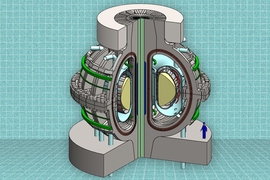On the Sunday of Columbus Day weekend, the control room of the MIT Plasma Science and Fusion Center’s (PSFC) Alcator C-Mod tokamak was as lively as on a typical weekday. But instead of being filled with researchers gathering the latest data from the fusion experiment, the space was filled with over 30 science writers and public information officers gathering insight into the current state of world fusion research, and the possibilities for the future. The enthusiastic group was attending ScienceWriters2015, the annual meeting of the National Association of Science Writers and the Council for the Advancement of Science Writing, this year hosted in Cambridge by the Knight Science Journalism program at MIT.
At the PSFC, Deputy Director Martin Greenwald welcomed the writers with a review of the fusion process and an overview of MIT fusion research, including new advances in superconducting magnet technology that could help reduce the size, cost, and complexity of a fusion power plant. Postdocs Ted Golfinopoulos and Bob Mumgaard guided the group into the C-Mod control room and the experimental cell where the tokamak is housed. Along the way, they showed the difference between typical superconductors and the newly developed thin superconducting tapes, demonstrated how plasma in a glow discharge tube responds to magnets, and fielded questions.
Ted Golfinopoulos revealed that the writers, like students and members of the public who attend PSFC tours, are interested in the question, “What are the biggest challenges toward achieving commercial application of fusion power?” Golfinopoulos answered that beyond the technical challenges, he believes “the biggest challenge that we face in the fusion community, as a whole, is similar to that faced by all clean energy technologies: earning the support from everyday people, as well as from leaders in the political and industrial spheres, that will enable us to realize the commercial application of our technology on a time scale that is soon enough to make a difference.”
The tour generated further inquiries from a number of writers, including Dave Mosher, who wrote an article for Tech Insider.









